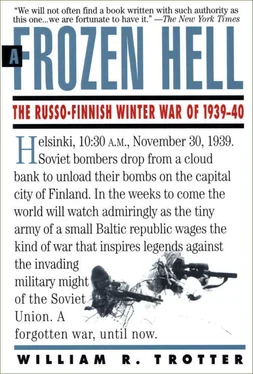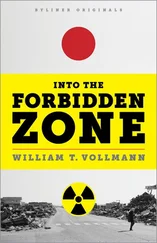Holsti and Cajander agreed that this move was out of the question. Even though the only people who ever went to those islets were summertime fishermen, they were still Finnish soil, and the domestic political climate would not permit them to be given to Russia.
Yartsev went back into the diplomatic chambers from whence he had emerged, and nothing further was heard about the matter until the spring of 1939. In March of that year, another Kremlin emissary broached the idea again, in somewhat more concrete terms. If Finland were willing to lease to Russia the island of Suursaari and four smaller islets in the gulf for a period of thirty years, then Russia would demonstrate good faith by offering a large slice of the disputed Karelian borderland in exchange.
Gustav Mannerheim was one of the handful of Finnish leaders privy to this second round of discussions, and he advocated giving the Russians what they wanted. The islands themselves were without value, and their loss could therefore hardly be interpreted as a blow to national prestige. It was folly, Mannerheim insisted, to adhere to such a stubborn policy vis-à-vis their giant eastern neighbor when the Finnish armed forces were not in any condition to back up that policy.
As Finland’s leading soldier, Mannerheim knew what he was talking about. In the spring of 1939, the Finnish Army did not yet possess a single operational antitank gun. There were only a dozen or so modern fighter planes in the entire air force. Communications equipment was primitive; the field radios used by Finnish ground troops weighed 300 pounds, and their tubes had a tendency to explode in cold weather. Machine gun ammunition was in such short supply that gunners were restricted to a dozen rounds of live ammo per training session. The Civic Guard and reserve units drilled with wooden rifles or rusty old tsarist relics. Stocks of shells for the artillery were alarmingly low, and many of the guns themselves dated from the Russo-Japanese War of 1905. Mannerheim tried to make the politicians see the bitter truth: zeal and patriotism were fine, but those were the only commodities his army had in abundance. The army was in no condition to wage war against the biggest and most lavishly equipped army in Europe.
Mannerheim’s gloomy reports were dismissed as no more than alarmist griping by an old militarist, and once again the politicians ignored this second batch of Soviet overtures. Time was growing short, however, and Russian pressure would continue to increase as the weeks went by.
That was because the Russians themselves were feeling pressured. To a Soviet strategist sitting in a map room in the Kremlin in the spring of 1939, no direction on the compass looked reassuring. And nowhere was the potential danger quite as glaring as it was in the direction of Leningrad—and Finland. Not only was Leningrad a major industrial center, it was the spiritual and cultural heart of the Communist state, the cradle of the revolution. The city had become a powerful symbolic entity; its loss, in a war with Nazi Germany, would hurt Russia more than the loss of a million infantry. The hypothetical Russian strategist, then, would have surveyed the situation with emotions not markedly different from those that had prompted Peter the Great’s concern about the sleeping ladies of Petersburg.
Stalin was no longer worried about Anglo-French cabals against him. By the spring of 1939, it had become clear that the only nation Stalin had genuine reason to fear was Nazi Germany. Already Hitler had moved into Austria, closer to the Balkans, closer to the Ukraine’s wheat and the oil fields at Baku. Stalin could see as clearly as the next statesman that such bankrupt concepts as “collective security” offered no comfort, and he could certainly see that no European state, not even one as militarily contemptible as Italy, need fear the moral condemnations of the League of Nations. In view of the Western powers’ long tradition of anticommunism, there seemed only the remotest chance of joining with those nations in a unified anti-German front. For Stalin and his generals, the conclusion seemed obvious: for the moment, given the realities of the day, Russia would have to go it alone. So, given the very real threat posed by Hitler, the record of close German-Finnish cooperation in 1918, and the realities of geography, the Russian viewpoint concerning Finland was not entirely unreasonable.
While events were accelerating in the northland, Hitler had been putting out secret feelers to the Kremlin. Hitler knew that Stalin needed two things: time in which to strengthen Russia’s defenses, and freedom from outside intervention if Russia felt obliged, for the sake of improving its defensive posture, to gobble up some neighboring country. Alone among European leaders at that moment, Hitler was in a position to offer him both, at no additional risk to his own designs. Given Hitler’s contempt for the Slavs, and his not-so-secret territorial ambitions to the east, it was obvious to both parties that this would be a marriage of convenience rather than mutual affection. Sooner or later, the deal would be revoked, probably by force, when it suited the führer to do so. Until that day came, however, the Nazi-Soviet pact was a most satisfying arrangement for both signatories.
As far as Finland was concerned, the agreement signed between the two dictatorships in August 1939 opened the way for Stalin’s plans by means of an “Additional Secret Protocol,” which defined the two signatories’ spheres of interest in the Baltic region:
In the event of a territorial and political rearrangement of the areas belonging to the Baltic States (Finland, Estonia, Latvia, Lithuania), the northern boundary of Lithuania shall represent the boundary of the spheres of influence of Germany and the USSR.
One week after the Nazi-Soviet pact was signed, Hitler invaded Poland. On September 17, Russia attacked Poland from the east, absorbing enough territory to give Stalin a “buffer zone” on that part of the USSR’s frontier. The foreign minister of Estonia was invited to Moscow on September 22, and only one week later an agreement was signed that gave Moscow the right to station troops, aircraft, and naval units in that small Baltic nation—in effect, to annex Estonia as a satellite. The foreign ministers of Latvia and Lithuania were invited to Moscow during the first week of October, and on the fifth and eleventh of that month, they too signed “mutual assistance” treaties with the USSR that would lead to their absorption into Stalin’s empire.
Another and similar summons went out on October 5, to the Finnish government in Helsinki. In form it was an invitation; in substance, it was a demand: a Finnish delegation should come to Moscow to discuss “concrete political questions.” In the words of Finnish historian Max Jakobsen: “For eighteen months, Finland had conducted a muted dialogue with her great neighbor; the Russians had from time to time softly asked a favor or two, and the Finns had politely whispered their refusal. Now the tone was changed: this time, there had been steel in Molotov’s voice.” [1] Jakobsen, Max, The Diplomacy of the Winter War (Cambridge, Mass.: Harvard University Press, 1961), 106.
At the first high-level meeting in Moscow, on October 12, Stalin wasted no time putting his demands on the table. His main strategic problem, he said, was the vulnerability of the frontiers around Leningrad. In order to improve the city’s security, he needed—indeed, he must have—the strongest possible assurances of continued good relations with Finland. Given the chaos that had recently engulfed Europe, he had serious fears about the possibility of an attack against that sensitive part of the Soviet Union, either from the Gulf of Finland or from the Finnish mainland.
Читать дальше












